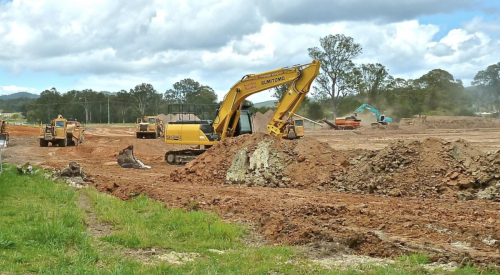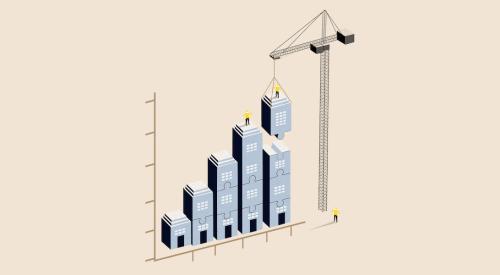 |
They call it a cycle for a reason: what goes down eventually bounces back up. Patience is a stratagem for anyone caught in the act of trying to sell a home building company. The housing market will be different when it recovers, and almost certainly, the universe of potential buyers for building companies will increase. The next order of business for a seller will be to anticipate those changes and prepare for them with a company tuned to the new dynamics of an emerging marketplace; a company that leads the recovery will have marketable value.
Reality CheckManagement consultants and brokers who specialize in putting together mergers and acquisitions in the housing industry say one of their hardest tasks is convincing private production builders who want to sell a company that they are selling future earnings, not past performance.
"Builders think what's valuable is their 10-year earnings record and reputation in the marketplace," says Colorado-based management consultant and GIANTS columnist Chuck Shinn. "The truth is that's just window dressing. It lends some credibility to their projections of future earnings. But what buyers are really interested in are the land, people and systems that will generate immediate earnings next year.
"If your past performance was due to a land position you no longer have and you don't have another one of equal value, no one is going to pay a premium for the company," Shinn warns. "Entitled land is the first prerequisite, followed by the people, systems and processes to put the right product, at the right price, on that land. Backlogged sales were valued until this downturn showed backlogs to be somewhat suspect.
"Most private builders have put their lives into their companies for 20 years or more, and they think that's what they're selling — the work of a lifetime," Shinn says. "They can't understand that the only thing a buyer is interested in is the immediate earnings stream that flows from the land assets."
There's the next rub. The public home builders were the most active acquirers over the 13-year boom that ended in 2005. And right now, they're dumping land — not buying — and they're not showing much interest in company acquisitions either. No deals have closed since June. So unless you're holding entitled land (or better yet, developed lots) bought several years before the recent land price run-ups, don't hold your breath waiting for a public builder with an offer for your company that will send you into retirement.
The current market downturn was caused not by an economic recession but by double-digit housing price increases fueled by a feeding frenzy of speculative buyers — flippers — who never intended to move into the houses. Many markets were overbuilt, and when the speculators bailed a year ago, they left behind excess inventories that pushed prices down, especially when the public builders began dumping product at six-figure discounts.
The good news is that the economy is still strong. Federal Reserve Chairman Ben S. Bernanke said recently that although the housing market slowdown is likely to be a drag on economic growth in 2007, the economy beyond the housing market is expanding at a solid rate. He told a New York audience, "Over the next year or so, the economy appears likely to expand at a moderate rate, close to or modestly below the economy's long-run sustainable pace."
"To date, there is little evidence that the weakness in housing markets is spilling over more broadly to consumer spending," Bernanke said, pointing to rising new home sales in August and September as signs that the housing industry may be stabilizing.
The sales slump will not last forever, and if the economy remains robust, pent-up demand for housing might drive a strong recovery once consumers are convinced that prices have hit their low point and they regain faith in future price appreciation.
The bad news is that, right now, no one wants to pay too much for a house — or a home building company. Price corrections are working their way through every element of the industry and, as always, land sellers will be the last to drop prices. The land you may be holding that would normally be the key asset to drive the sale of your company may not pencil for a project in the coming housing recovery.
We're already seeing a softening of terms on land deals, probably because so much land is coming back on the market. However, prices have not come down (at least not yet), even though the supply of land on the market is increasing dramatically. The public builders continue to walk away from millions of dollars in option deposits, which brings more land every day back onto the market.
"If there was any sense this was going to last beyond 2007, we'd see developers beginning to try something different rather than just stonewalling on price," says Florida-based mergers and acquisitions specialist and GIANTS columnist Jody Kahn Kline of Michael P. Kahn and Associates. Kline believes that when sales come back, they will plateau at a lower volume than through most of the first half of this decade. "Some of the builders we talk to say they are re-bidding all their labor contracts, which just shows how fundamental this price correction is," she says. "Some companies are reporting as much as 12 percent reductions in hard costs."
All of this cycling down of home prices and costs is already reflected in valuations of home building companies. "They have come down," says mergers and acquisitions consultant Tony Avila of San Francisco-based JMP Securities. "Buyers are looking at book value, and it's doubtful any seller will get much of a premium to book. In fact, they may have to take a discount to book to get a deal.
"The reason is that margins are now significantly less than in 2005. Somebody who has held onto land quite a long time with entitlements in place and a low basis in that land may get a little premium. But any land bought in the last two years is going to be valued at a significant discount to book," Avila says.
What's Next?Over the years, we've seen different formulas put for valuing home building companies: one and a half times book; five times EBIT; and four times after-tax income, to name a few. Those multiples may be valuable as discussion points, but they're not likely to hold through the long negotiations that lead to a closed deal on the sale of a building company, especially in the revamped industry that will emerge in the housing recovery to come.
"A home building company is only as good as its next site. The product is location more than anything else — and you always have to find new customers," says New Hampshire-based mergers and acquisitions consultant Ron Robichaud of Robichaud Associates. "The income predictability is not there for builders as it is in other industries."
A builder has four things to sell, Robichaud says:
- Lot positions. "Good land is golden," he says. "But every site is different ... and you need to get it at the right price."
- The machine. "People, operating systems, relationships with land sellers, trades, vendors — it's everything about the business model and product positioning. This is not a science. But taking lot positions and running them through a discounted cash flow projection makes sense — that's a way to look at the income potential of assets in hand."
- The backlog. Houses sold but not yet built. "There's some profit potential there, but we're learning in this slowdown that backlog is not a sure thing," Robichaud laughs.
- Upside growth potential. "If the company is in a market with 2,000 housing starts a year, it's going to be tough to grow it into a 4,000 unit-a-year builder. But in a market like Atlanta, with 60,000 starts a year, you have the upside potential to grow."
The first thing a potential buyer will look at is the value of assets on the books, Robichaud says. "For a decade, we've been looking for hidden value over book. We assumed there was more value in the assets than what showed on the balance sheet. But today, that's no longer true. Land, especially, may be on the books at a higher cost than its value in today's market," he says.
For most who purchase companies, the alternative to buy an existing builder is doing a start-up. Looking at it from that perspective, it's easy to see that a functioning production building machine — especially with a strong management team in place — has some value that would be hard to match. Proven profit producers with the ability to continue profitable operations are hard to find Many of the people who work on mergers and acquisitions believe that public home builders may not dominate the next round of acquisitions. "We've seen an increase in the activity of private builders for several years," says Robichaud, "but the people who bought home builders have always been other builders. That may not be the case in the future. People outside the housing industry may begin to buy home builders — syndicates of investors, for instance, maybe from outside the country. The return on capital that a home builder can achieve is very attractive, and you can mitigate the risk. "The biggest danger to a well-run home builder is running out of cash (usually by being unable to cover the leverage on land bought at the peak of a cycle). But if you have enough cash to hold on long enough, the market always comes back," Robichaud says. "The public builders will still buy companies, but I think they're going to get some new competition. Perhaps private investment groups that, instead of buying the stock of a public home builder, would buy controlling interest in a private home building company. The group would keep the management team in place, with minority equity positions to keep them motivated. The investors would see returns on equity of 30 percent to 50 percent, year after year," Robichaud argues. Avila believes the public builders will move back into acquisitions in 2007, but he, too, predicts more players will get into the fray. "Private equity shops, real-estate opportunity funds — JMP is even creating a new public company that will be organized for the sole purpose of acquiring one well-managed private builder, keeping the management team in place to run it." Another player in the acquisition game is bound to be California-based John Laing Homes, itself acquired last summer by Dubai's Emaar Properties, which stated its intention to grow Laing into a $10 billion company within five years.Here's how to move your company into position to lead the housing recovery and also make it attractive to the new players who will soon be sizing up acquisition targets:
- Call an acquisitions specialist to sift through the assets on your balance sheet and assess how to maximize future earnings potential. What's the best strategy to maneuver the company into land positions that match opportunities that emerge as the market recovers? "Don't sell land unless you're over-leveraged," says Avila. "Buy land if you can. It's a buyer's market today."
- Keep the management team together. "It's a value differentiator," says Kahn Kline. "You spend so much to develop it, it makes sense to do almost anything to keep from breaking up that team. This downturn will not last beyond 2007. Management talent is critical to potential buyers."
- If your goal is to retire, get an experienced chief operating officer in place. "Find someone who can run the company better than you," says Robichaud, "a professional manager who can squeeze out costs and breed continuous incremental improvements. Most builders are entrepreneurs, not professional managers. Buyers want to see a leader in place."
- Separate the building company from other operations. "We often see land, home building, multi-family apartments, lumber yards, truss and panel plants all run through one set of books," Shinn says. "You can't tell what's making money and what's not. A buyer will probably want only land assets and the home building company. Separate the others so they can be sold separately."
- Renegotiate all your labor pricing and materials contracts. "The value of everything changes when the market crashes," says Tom Bradbury, former owner of Colony Homes in Atlanta, who sold his company to KB Home in 2003. "If you don't do that, you won't be able to meet the price competition when the market comes back. If you're in the right spot in a good market and somebody wants that spot, they will pay you a premium to get it. That's what happened to us."












